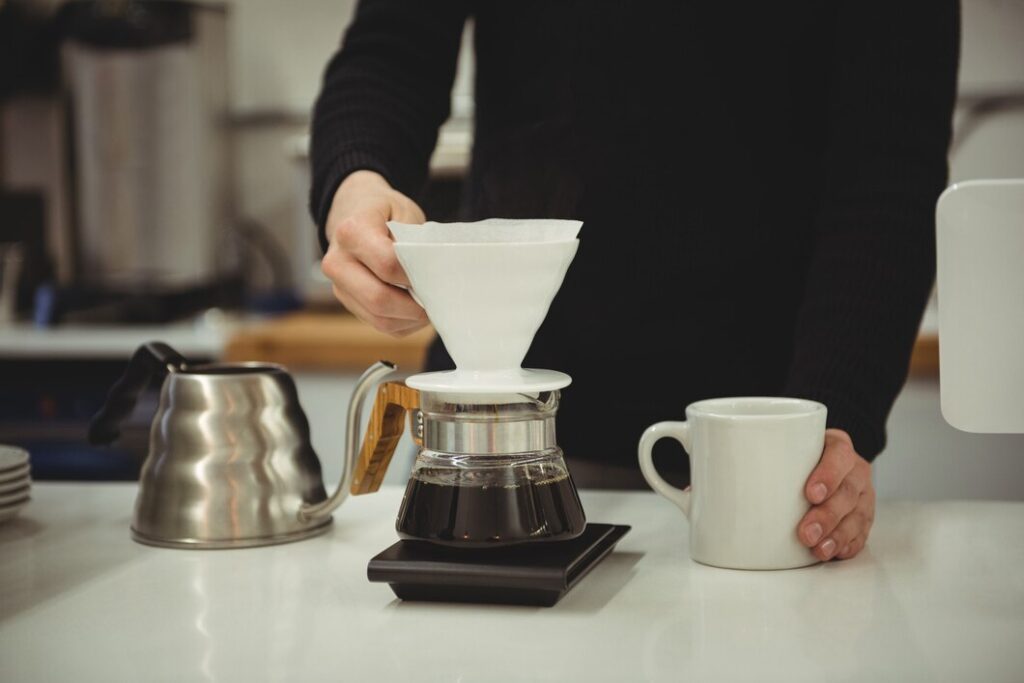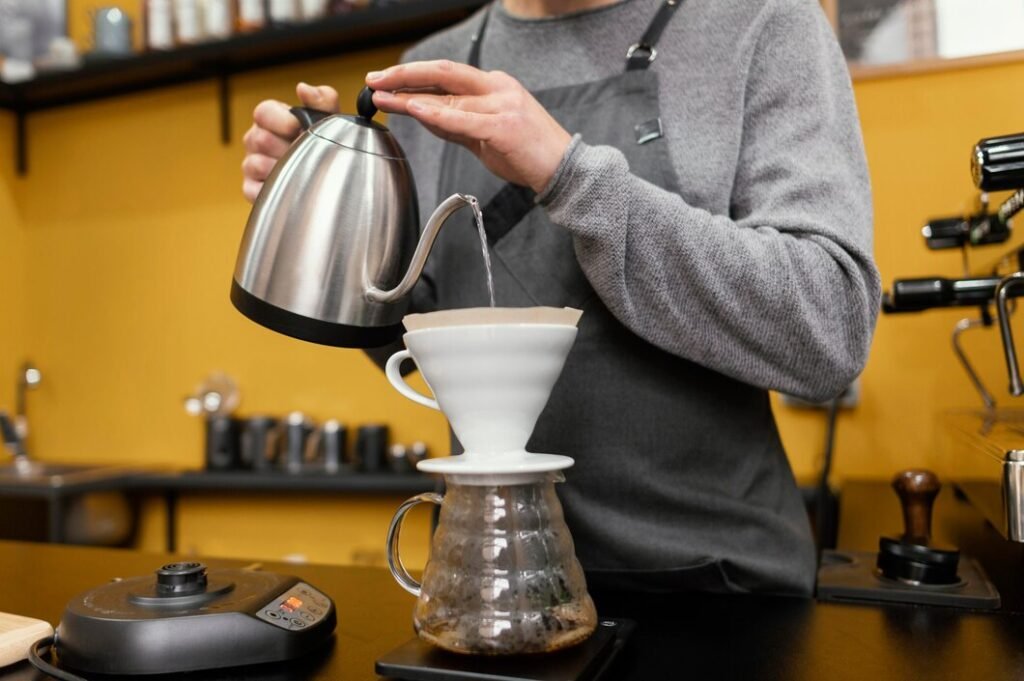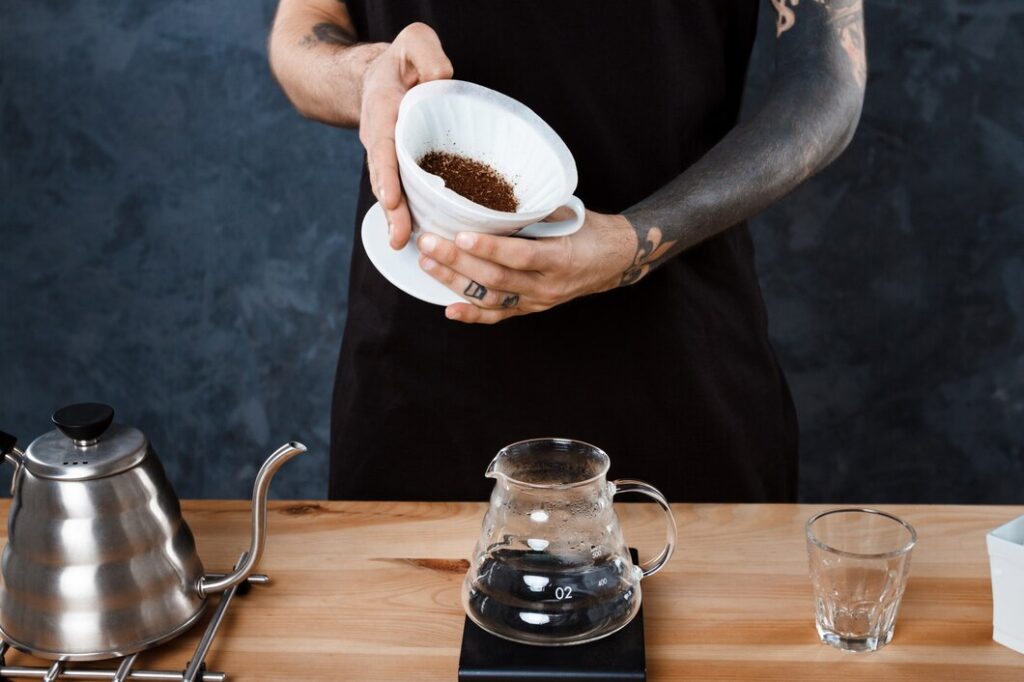Filter coffee is an innovative way of brewing coffee. The process is simple and can be done using a manual drip coffee maker. The process involves the use of a paper filter, which is placed into the bottom of the pot.
Then the boiling water is poured into the pot, and a manual drip coffee maker is set to a timer so that the beans will spin, infusing the water with aroma.
The concept of filter coffee originated in Japan, where it was first introduced as a tea brewing method. The idea then spread to Europe and North America, where it became popular due to its simplicity and effectiveness. Everything else considered, filter coffee is an innovative way to brew your morning cup of Joe.

What Are The Different Types Of Filters For Coffee?
Coffee filters are used for filtering out all the coffee grounds from your brewed coffee. This can be done efficiently using a paper or expensive paper-based filter. However, these paper filters can be expensive or even impossible to find in some households.
For households that do not have access to either of these types of filters, a kitchen towel can serve as an effective substitute and save both time and money. But what type of filter should you buy and use in your coffeemaker?
This article will also discuss the different types of filters for your coffee. The most popular filter types are listed below:
-
- Paper Filters
Paper filters are the cheapest and most common type of filter. They can be found at any grocery store or purchased online at a low price.
- Paper Filters
A paper filter is a thin material separating the ground beans from the brewed coffee. The grounds are pushed through the paper filter and into a wire mesh basket or cone, where they are held back from the brewing water by a layer of cloth. Paper filters can be used in different ways to help control how much sediment and bitterness gets into your cup.
-
- Plastic Filters
Plastic filters are reusable and have a permanent shape, allowing for better temperature control when brewing coffee. Plastic filters for coffee use a different type of material than paper. They are usually made of plastic, nylon, or metal mesh.
- Plastic Filters
The big advantage of plastic filters is that they filter out more than 99% of the coffee grounds and can be reused up to 500 times. They also have a higher capacity to remove oils and fats from the water than paper filters.
-
- Golden Brown Filters
These filters will give you the best flavour when used with an espresso machine or drip coffee maker, but they will also increase the bitterness in your coffee. Golden brown filters for coffee are a popular trend in the coffee industry. The golden brown filters add a rich taste to the coffee, giving it a more luxurious feel.
- Golden Brown Filters
Many coffee roasters, cafés, and home brewers use these golden brown filters because they provide a unique flavour not found in traditional brewing methods. They are most commonly used to enhance coffee’s taste without adding extra ingredients or chemicals.
Your Guide To Making The Perfect Filter Coffee

Filter coffee is an art that requires a lot of practice and patience. It can be difficult to learn the right way to make coffee without having any experience.
Depending on the type of beans you use, how coarsely they are ground, and how much water you use, the time it takes to prepare your filter coffee may vary. This article will help you start your first pour-over and simplify your coffee-making process.
These instructions may be useful in making filter coffee.
-
- Grind the beans to a medium-coarse level and use a scale, if you have one, to measure them out according to weight, not volume. For example, 1 tablespoon is approximately 3 grams of coffee beans ground up with a mortar and pestle or grinders attachment on your coffee grinder. A good rule of thumb for standard grinds is 18 grams per 6 ounces (21 grams per ounce).
-
- Place the filter in the cone and then into the pot so it sits about one inch below its rim (this is where your coffee will drain).
-
- Prepare a hot water-coffee solution, making sure to boil the water before pouring it into the cone. It is important to use freshly boiled water for this recipe. Boiled and cooled or room temperature water makes bad pour-overs as they can result in bitter flavours and/or over-extraction.
-
- With a spoon or scoop, slowly pour small amounts of hot coffee into the cone so that it fills up only halfway and then immediately drop back onto the scale to get an accurate weight of liquid in grams per time measured by grams after each pour.
-
- Once the weight has been reached, stir the coffee and slowly add more hot water to fill the cone up to its maximum capacity while allowing enough time for it to drain out of the bottom before repeating step 5 so that you can get an accurate total weight measurement of liquid in milligrams per time measured by mls after each pour.
-
- When you’re finished with your pour-over, place a small strip of paper towel on top of your freshly made beverage and enjoy!
The Best Coffee Brewing Methods

The manual drip coffee makers are great for those who want to make their filter coffee at home. It allows them to create a cup of coffee with the perfect flavour and consistency. There are many ways to use a manual drip coffee maker.
In brewing your filter coffee, these methods are also considered.
-
- Pour-Over Method: The pour-over method is the most common type of brewing, where hot water is poured over a bed of coffee grounds. This process is sometimes referred to as a “brewing” technique. There are different pour-over methods, but they all boil down to pouring water on coffee grounds, allowing the water to pass through slowly and evenly.
-
- French Press Method: This technique involves using a French press that uses small, circular filters that trap the grounds inside the device. The water and coffee are boiled and poured into the press through an opening in its lower chamber. This method allows for more sediment to remain in your cup than other methods because it removes less water from the grounds before brewing them.
-
- The Aeropress Method employs a filter cone at one end of a chamber, and the user places ground coffee at the other end and then uses a plunger-like apparatus to extract the coffee’s flavour.
-
- Stovetop Method: Similar to the pour-over technique, this method uses a stovetop or electric coffee maker with a cone-shaped filter to brew coffee. The burner is set to medium heat, and the coffee is left to steep for a few minutes before brewing.
-
- V60 Method: The V60 Method includes a glass cylinder with an upper chamber on one end and a lower chamber on the other. As water is poured over grounds in the lower chamber, it flows into the upper chamber, creating even extraction for those who enjoy stronger brews.
Conclusion
Filter coffee is a great way to enjoy the taste of coffee without the hassle of grinding beans. It is also a great idea for people just starting their morning routine who want to avoid the steep learning curve associated with brewing methods. Now that you’ve done it, you can get some sleep and enjoy that perfect cup of coffee in the morning.
Was this article helpful? Let us know in the comments.
FAQs
What happens if you drink coffee without a filter?
Without a filter, some of the oily compounds called diterpenes in coffee beans end up in your cup. Coffee connoisseurs claim that these oils improve the flavour of the brew. Diterpenes have been demonstrated to have a detrimental effect on health, so you should be aware of that.
How many times can you use coffee filters?
Most people discard their coffee filters too soon, which results in wasteful spending. Although paper filters are frequently advertised as single-use products, you can easily use a single filter three or four times before the quality of your coffee begins to deteriorate.
Does filter affect coffee taste?
The final flavour of the brewed coffee will vary depending on the type of filtration used. A greater amount of the coffee oils will be absorbed, and some flavour will be removed by filters made of absorbent fibres, such as cloth or paper filters.




